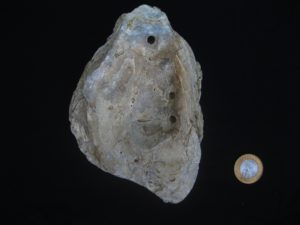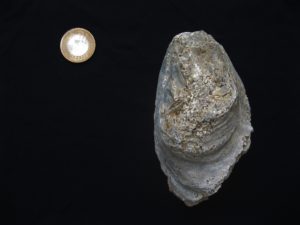Riffin T Sajeev*
Department of Geology, Periyar University, Salem,INDIA .*riffin@rediffmail.com
The eastern coast lines of southern India are rarely used to study its paleontological importance. Living oysters of Crassostrea Sp. are found throughout these coastal margins. Recent reports indicate the existence of a paleo-estuary dated to the mio-pliocene age, along the valleys of the southern end of Western Ghats. About 70 specimen of Crassostrea Sp. have been sampled from this area of which, almost 80 percent are disarticulated and observed as subjected to the predatory action of ichnotaxa.

Crassostrea Fossil with action of ichnotaxa. (c) World Fossil Society. Photo Courtesy @Riffin T Sajeev & Russel T Sajeev
All oysters seem to have adapted extremely thick layered calcite shells, which is a remarkable morphological feature. Bore holes and biodegradation are seen in an extreme magnitude. A previous work of the author describes the existence of a giant Paleo-estuary which existed along the eastern coastlines of India during the mio-pliocene age, based on the morphological and taxonomical features of Crassostrea Sp. from the same area. The proposed work is a detailed analysis of the Predatory signatures on shell fragments by ichospecies in the proposed paleo-estuary during the mio-pliocene age.

Crassostrea Fossil with action of ichnotaxa. (c) World Fossil Society. Photo Courtesy @ Riffin T Sajeev & Russel T Sajeev
In this study, the author analyzes the nature of the ichnospecies that thrived among these oysters, their threat to the life of oysters and their contribution towards the necessity for an adaptation of a thick layered shell on these oysters. The study proposes to identify each ichnotaxa by analyzing their predatory pattern and the style of biodegradation on the host shells. The study also proposes to explain the paleo-climate and paleo-topography and further insight to the nature of sediments in the estuary during the mio-pliocene, based on the features on the samples of Crassostrea Sp.
Citation: Geological Society Of America Annual meeting At Denver,2016
Key: WFS,World Fossil Society,Riffin T Sajeev,Russel T Sajeev



 August 4th, 2016
August 4th, 2016  Riffin
Riffin  Posted in
Posted in  Tags:
Tags: 